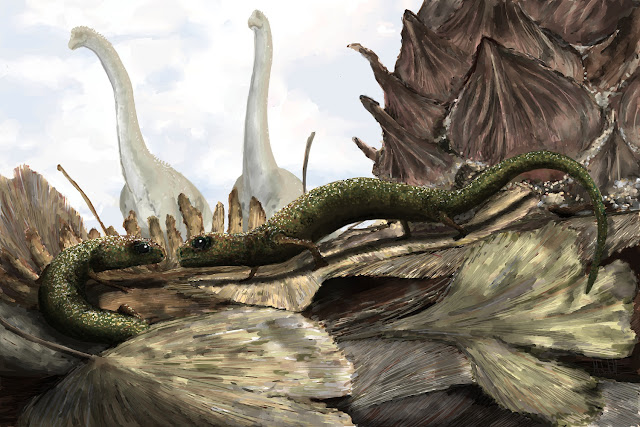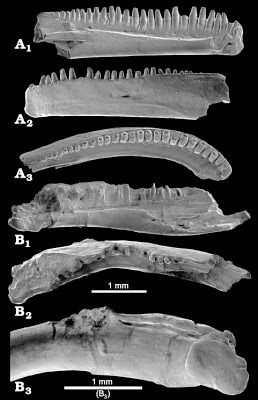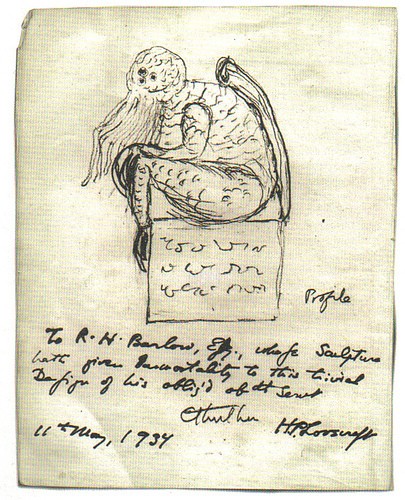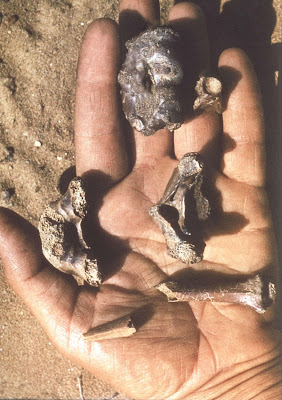![]() |
| A Mesozoic slope supporting a nesting Torvosaurus tanneri, one of the biggest and most distinctive predators of the Jurassic, and yet strangely under-represented in palaeoart compared to other theropods. I'm not sure why: we should be queueing up to draw this thing. Long body plan, a skull and teeth that go all the way up, and a maxilla that won't quit. What's not to like? |
Palaeoartists are obsessed with rendering fossil animals accurately. It's part of the job. The latest palaeontological research is grilled for data which can inform the appearance, posture and behaviour of their subject matter, allowing them to recreate ancient life in the most accurate manner currently available. Accordingly, the harshest scrutiny applied to any painting or sculpture of a fossil taxon concerns the anatomy of its creatures. Do their bone structure and proportions match the fossils? Are the muscles big enough and attaching in the right places? Does the integument match up to fossil data? Get those wrong, and the reconstruction isn't truly successful, because it doesn't accurately reflect reality.Beyond the animals themselves however, are other choices which are relevant to achieving a sense of realism in palaeoart: the basic composition of the image or sculpture itself. The landscape, the setting, the
mise en scène. For all of the excellent palaeoart out there, I think virtually all of us are guilty of some stylistic choices which may work
against making our images looking totally convincing. This isn't because of problems with artistic ability or approach but instead, as
All Yesterdayspointed out for animal reconstructions, some stylistic conventions have become so overused that they've become tropes and stereotypes. Once you notice them, it's hard to forget that you're basically looking at a product of imagination. In other instances, we perhaps unintentionally lean too heavily on pieces of influential but inaccurate artwork or have simply developed habits which, viewed from within the looking glass, are actually a little strange.
It's these stylistic issues that I want to talk about here. There are lots of quirks and niggles we could cover - they become very numerous once you start thinking about them - but, in this post, we're going to pick on my personal top four stylistic points that jar my sense of disbelief. Before we get going, I think I should remind everyone that this is very much an opinion piece, and please feel free to tell me where to get off if you disagree with these points. Moreover, I count myself as guilty as anyone else in perpetuating some of the tropes and annoyances discussed here, and I'm certainly not having a pop at anyone in particular. The goal here is to get us thinking, that's all. Just for fun, I've assigned a five point 'Reality Crash Rating' to each, with scores of one meaning that I think something is in danger of becoming a negative stereotype eroding palaeoartistic credibility, and five being a habit that we should all snub and divorce immediately because it completely ruins the illusion of an ancient world. All set? OK, off we go.
1. The Mesozoic, ripe for Dalek conquestIt's a well known that the famous
Doctor Who villains, the Daleks, were perceived to
struggle with complex terrain and stairs for much of their televisual history. This became such a joke that the show itself had a few pokes at that obvious failing of their most famous antagonists. Of course, recent advances in Dalek technology (and er, BBC VFX) negate these problems for modern episodes, but even a roadside kerb would be a bit of an issue for an onscreen Dalek for much of the series history. What does this have to do with anything? Palaeoartistic work indicates Daleks would do a heck of a lot better if they just invaded the Mesozoic. Completely flat, horizontal ground stretching way off into the distance seem to occur in the overwhelming majority of palaeoart scenes. Go and Google some for yourself to check. See what I mean? Sure, there may be some highlands and forests as a far-off backdrops and even sometimes in the middle distance, but the animals themselves keep to flat stages without inclination or slope. What's more, as pointed out by Duane Nash at
Antediluvian Salad, said animals often occupy patches of bare earth without vegetation. Frankly, I can't imagine a superior Dalek holiday spot.
![]() |
"Puny Earthlings: your mighty stairs cannot save you this time! Exterminate! Exterminate!"
(Hasty composition thrown together with awesome sauropod artwork by Mark Hallett, borrowed from here, and Daleks borrowed from The Mind Robber). |
It's obvious why our palaeoart landscapes are generally so flat. Most palaeoartists are interested in showing off as much of their animals as they can, and sometimes as many animals as they can, and a flat stage is a pretty good way to do that. And yes, many animals from terrestrial biomes are preserved in ancient floodplain deposits, so much of their local landscape probably was fairly flat. Interestingly, the most common alternative to flat ground is complex and tiered environments such as forests (with obligatory fallen trees) and rocky outcrops. It's either a flat stage, or backgrounds so awesome that they dwarf their animals. There's not much in the way of middle ground.
Reality Crash Rating: 2/5We might ask ourselves if this matters or not. I mean, the images are about the animals, right? Who cares what the terrain is like? I think it
does matter, though. Our planet isn't just comprised of flat, open space bordered by dramatic valleys, giant dunes and redwood forests. A lot of it is just a little bit hilly, with immature woodlands and, you know, little gullies and stuff. There's no reason to think the planet has had a significantly different landscape for much of its recent history, and I think we should try to reflect that in our artwork. Adding a few slopes and inclinations to an image gives the terrain a little bit of character and goes a long way to making a setting look like an actual location, one that we could stumble across ourselves on hikes and walks in our own countrysides. Überflat or superforested settings, but contrast, are more 'extreme' environments that certainly exist, but comprise considerably less of the Earth than palaeoart suggests (even correcting for anthropic factors). What's more, they're so commonplace now that they've become a bit generic: how many images of ceratopsids in dense forest are there? Or sauropods on open, flat ground? I'm amazed at how much more believable images look once a few slopes and inclines are added: check out
John Conway's sauropod herds for the impact that adding some slight topography can have. I like that series of pictures so much because many of them have unusual topography, which makes it seem far more like John went out and painted some real sauropods
from a real location.
2. FranchisosaursHow many recreated extinct species owe significant aspects of their reconstruction to popular franchises? Regular readers may recall touching on this problem when considering
Feather Resistance a few months ago. If animals are reconstructed memorably in film and literature they run a chance of being forever depicted in that same guise in popular media.
Jurassic Park and the
Walking with... series
are probably the biggest modern focal points for these sort of homages, as the work of famous palaeoartists Charles Knight and Zdenek Burian were before them. The influence of these works is typically fairly muted among professional or, shall we say, 'dedicated' palaeoartists, but is rampant among
toy and model manufacturers,
book illustrators and more 'casual' palaeoartists.
![]() |
| Vladimir Bondar's Jurassic Park dromaeosaurs, recently given a baffling rebranding as Torvosaurusin a media release. Seriously, what happened there? Note the animal in the middle distance is directly mirrored in this still from Jurassic Park III. Image borrowed from Lusodinos. |
Reality Crash Rating: 5/5
Does a little bit of copying from other work matter? I mean, why not take a cool looking depiction of a fossil species and use it again if you like it? On the one hand, no. Taking an existing colour scheme or plumage pattern and tacking it to a new reconstruction may be unimaginative, but it's not the end of the world. All out copying of franchise animal anatomy is risky however, because many famous reconstructions of prehistoric species don't reflect modern thoughts on the appearance of fossil animals. The reason for this is not, as you may expect, just because they've fallen behind palaeontological science. Sometimes, they were
never accurate in the first place. This applies to several modern franchises. The much-copied, cool-looking arches above the eyes of
Jurassic Park Tyrannosaurus? Nothing like that on real
Tyrannosaurus skulls. The ridges on the headcrest on the
Walking with Dinosaurs Tupandactylus(called '
Tapejara' in the show)? Not sure why they're there, as the fossils show nothing like that. Of course, it goes without saying that virtually all famous maniraptoran dinosaur reconstructions are a million miles away from their extinct counterparts. And these are just the examples that first spring to mind.
I guess the reasons for depicting 'incorrect' species in modern franchises are many. Sometimes the technology just isn't there to render anatomies convincingly (I believe this explains the general lack of feathers and other fuzz in the original Walking with Dinosaurs), and maybe some inaccuracies are just honest mistakes. Often, however, these anatomical discrepancies are often introduced in spite of technical guidance. It is extremely common for filmmakers to tweak designs or just plain ignore suggested changes from consultants, and sometimes they have no real regard for accuracy at all. For whatever reason, franchise reconstructions frequently only partly resemble actual fossils species despite their slick on screen rendering, and thus are moving towards being fantasy creatures (to greater and lesser extent, of course) than reconstructions of ancient realities. The obvious moral is to base reconstructions on up-to-date, scientifically rigorous skeletal reconstructions and fossils themselves, and take only inspiration from our favourite palaeo-themed media. No news at all to practised palaeoartists then, but clearly a lesson that other artists would do well to learn.
3. The Slasher PoseThe tension of many slasher movies is broken with a classic shot of an antagonist leaping directly at the camera from obscurity, arms agape and weapons ready to grab and hack whichever young starlet has just stumbled past their hiding place. It's what I'll term the Slasher pose. When used well, it's certain to burn that moment into the mind of the audience who've just spilt their popcorn in terror and, despite being clichéd and a cheap scare, it's featured in many of the best horror films of all time.
A completely different medium has recently latched onto the Slasher Pose, also to reveal creatures to audiences from obscurity: palaeoart. How many press release images of new dinosaur species feature animals with their faces and hands careering towards the viewer, usually while running, jumping or doing something else dramatic at the same time? Classic Slasher Poses, every one of them. It's even better if said animal has some nasty teeth, claws or horns: get those in our faces to show us how
weird and nasty this guy was. It's not just press releases where we see this concept either. If you want to 'refresh' the appearance of a familiar species, or else make things look bodacious for the kidz*, Slasher Poses are the Go To posture. Nothing says "X-TR3ME!" like a dinosaur posed so we can check out the content of its nostrils. A variant on this trope is to show a similarly posed animal without the distorting perspective. They still very much look like they wants to grab you or twat you around the face with some neon claws, but they aren't so close to the viewer.
*I'm reassured that this is the sort of language kids are into nowadays. God forbid the idea that I'm one of those cats who's lost touch with modern youth. That'd be so square.![]() |
| The most ungodly and terrifying theizinosaur in the world. Seriously: look at it. Part Freddie Fruger, part jabberwock, all terror. Classic Slasher Pose action. Photograph from The Birds & The Peas. |
Reality Crash Rating: 3/5To an extent, the use of Slasher Poses is a purely stylistic choice that no-one can really moan about objectively. I'm sure plenty of fossil species adopted such postures on occasion and, who knows, maybe they also got in each others faces while doing so. I do have to admit not being a fan of Slasher Poses personally. For all of their conveyance of prehistoric animals as dynamic and exciting, Slasher Posed animals look a bit cartoony. This isn't a problem restricted to dinosaurs. Even fictitious creatures specifically designed to look menacing or cool can't pull off Slasher Poses in still images (below), and I personally don't think it's an effective way to reconstruct real species. I've
speculated before that Slasher Poses may even be a factor in the lack of 'acceptance' of feathered dinosaurs by the general public. Such artwork was definitely in vogue when feathered dinosaurs were first being discovered
en masse in China, so many of the first images we saw of these animals were improbably cartoony and somewhat weird-looking. They were certainly nowhere near as cool as their scaly forebears, and perhaps did little to warm people to the most significant discoveries in recent dinosaur palaeontology. In addition, Slasher Poses are of questionable use from a purely functional perspective. They actually don't tell us much about the anatomy of the animal because its either obscured by enormous, perspective-enlarged heads or is distorted by foreshortening.
![]() |
| This scares the pants off me when it's a quick, rapid cut at the end of a tense scene. Freezeframed, it looks a lot less menacing, and almost a bit silly. If Geiger's xenomorphs can't pull off a Slasher Pose, despite being one of the coolest creature designs of all time, nothing can. Image borrowed from You've Got Red on You. |
Of course, the above is my entirely subjective view. There is perhaps one objective reason why Slasher Poses may be considered a bad habit for palaeoartists, however. Slasher Posed imagery is completely at odds with the way we observe modern animals (excluding those unfortunate few who get on the wrong end of a large, dangerous species). The postures and perspectives are so contrary to our own animal experiences that they can't fool viewers into thinking that the artist has drawn something real, but are clearly largely derived from imagination. If, as discussed above, a goal in palaeoart is convincing viewers that the artist has actually seen the worlds they're reconstructing, this is a problem. In addition, the frequency that we see Slasher Poses suggest extinct animals were pulling them all the time, but, if modern animals are anything to go by, they would have spent much of their time looking subdued and less dynamic. Paintings of calmer, more distant animals may not be as exciting as Slasher Pose works, but they're a heck of a lot more convincing (see below for more on animal posture in palaeoart). To me, Slasher Poses seem to be more about trying to make animals look awesome than they are about depicting reality. If the latter is our intended goal, Slasher Poses probably aren't the way to reach it.
4. ROOOOAAAARRRR!!!If there's one thing extinct animals do well, it's
roaring. Roaring, roaring, roaring. All the places, all the time.
Some species are hardly ever depicted with their mouths shut because they're too busy bellowing their lungs out at absolutely anything. Alone or in groups, exerting themselves or just standing around, they're roaring at
something. When combined with Slasher Poses - which frequently happens - it's
us being roared at, but there's frequently nothing obviously on the end of all this
noise. I assume said animals are just angry with passing clouds or having a sugar crash. The award for Most Tinnitus Inducing Prehistoric Species undeniably belongs to dinosaurs, and particularly to big theropods who are almost entirely incapable of quiet expression. It's like the entire world left Caps Lock on for 180 million years.
![]() |
| Dinosaur social networking must have been a nightmare to read. 'Profile pictures' by John Sibbick, Luis Rey, Todd Marshall, Papo, Walking with Dinosaurs and Raul Martin. |
Reality Crash Rating: 4/5OK, I'll put my cards on the table now: the roaring trope really annoys me. I get
why people want their dinosaurs and other prehistoric animals roaring and vocalisation all the time. It looks dramatic and suits some compositions well. The end of the first
Jurassic Park movie would've been a let down if the
Tyrannosaurus just killed the dromaeosaurs and then just quietly walked away, for instance. But do fossil animals have to be loudly vocalising so frequently? Take a look at the animals we see in every day life: they aren't forever making noise. Vocalising has a specific function, a time and place to be used. That time is not 'all the time', and the place is not 'everywhere'. We need to think harder about when fossil animals should be screaming and growling, and when they should being shutting the Hell up. For instance, why, dear Lord why, are there so many reconstructions of extinct predators and prey animals roaring at one another? Bear in mind that predatory acts
are strenuous. The prey animals are
running or fighting for their lives, while the predator is using precious energy to catch and kill them. Both are at extremely high risk of injury or death. Does it make sense to have these animals yelling at each other, using precious effort and concentration to do so, and sometimes even looking at each other
while running to
maximise the dramatic effect? Almost certainly not. Predators and prey should look focussed on the task at hand, not waving their heads around screaming like babies. Presumably, this focus is why modern animals
keep quiet during crucial moments in predator/prey interactions: they're literally in a life and death situation, not an action movie.
But it's not just choosing the right moment for depicting loud vocalisations that's important. When fossil species roar and vocalise, they should do in the same manner as their modern relatives. Dinosaurs and other fossil archosaurs are my big bug bear here. Unlike mammals, archosaurs don't need to open their mouths wide to make a heck of a lot of noise. For a cracking example, check out these bellowing alligators from
Colorado Gators (some of the best examples occur after the 3 minute mark).
Wonderful stuff, and all done without a single gaping mouth. All manner of hisses, squeaks and calls can come from archosaur throats
without waving their jaws around agape. Sure, they do use their mouths to control the pitch and volume of their vocalisations in many cases, but they don't need to resemble Pavarotti to achieve some magnificent noises. We really need to consider that before we draw yet another screaming tyrannosaur with widely gaped jaws. I suppose an argument could be made against this point that, without open jaws, viewers won't know that the animal is meant to be making any sound. This isn't entirely true, however: the throat sacs of vocalising archosaurs are often inflated to assist with noise production and pitch, and dinosaur throats were almost certainly doing the same thing (notice the workings of the throat sacs on the bellowing crocodylians above, for instance). I think we're simply become so accustomed to seeing dinosaurs vocalise in a mammalian fashion that we haven't really bothered to explore the many other sonic alternatives for these animals.
![]() |
| Aggressive snap display posture in the effectively mute marabou stork, where the body is lowered, the neck retracted and the bill is clattered towards an attacker. One of many threat displays in this species, and quite unlike most aggressive postures shown in restored dinosaurs. Image from Kahl (1966). |
There's more to this trope. Why do so many of our depicted vocalising archosaurs have the same basic elevated head and torso posture? Body language is extremely diverse and important to modern archosaurs, and social signalling doesn't always involve simply rearing up and yelling. There's all sorts of elaborate head movements, neck postures, torso orientations, and even tool use in play there. We only really show reconstructions of animals fighting and flirting, but modern archosaurs have body postures to reflect feelings of agitation, attract attention, indicate distress, for begging and even distinct copulation postures. The number of these within a species is compounded by differences in social stature, age and the nature of the stimulus. There's a lot of this stuff that could be incorporated into palaeoart. With all this in mind, we have a great opportunity to turn the infernal racket made by restored archosaurs into intelligent communication between the reconstructed animals, and more importantly, the viewer. There's a goldmine of language in ethology papers that we could be translating into our palaeoart, rather than just depicting animals roaring and telling us how big they are. (For more on this topic, check out Tetrapod Zoology Podcast
episode 6, and
this post.)
The end bitOn that noisy bombshell, it's time to wrap up for the time being. Again, I want to emphasise that this piece is not about palaeoartists 'getting it wrong'. It's simply saying that we may be guilty of becoming to comfortable with certain conventions which, for whatever reason, may be detrimental to the goal of reconstructing extinct animals. There's certainly many more things to say on topics like these. At one point, this post was going to feature 10 points, complete with the theme tune from BBC's
Pick of the Pops to count down with. Maybe I'll feature the other 6 if and when I get the time. Until then, feel free to make your own suggestions about compositional tropes or bad palaeoartistic habits in the comments below.
Reference- Kahl, M. P. 1966. A contribution to the ecology and reproductive biology of the Marabou Stork (Leptoptilos crumeniferus) in East Africa. Journal of Zoology, 148, 289-311.





































































